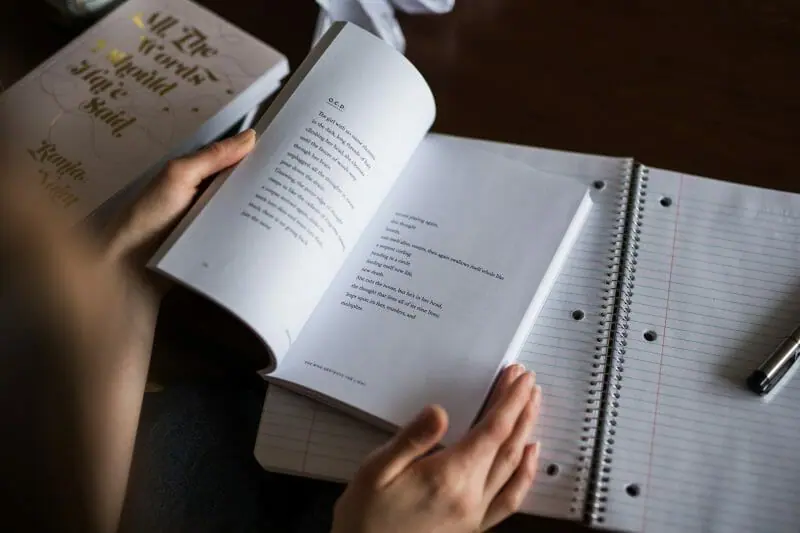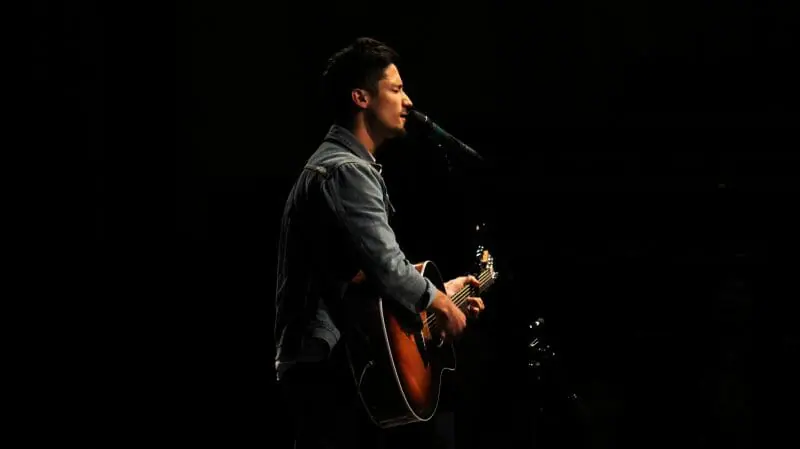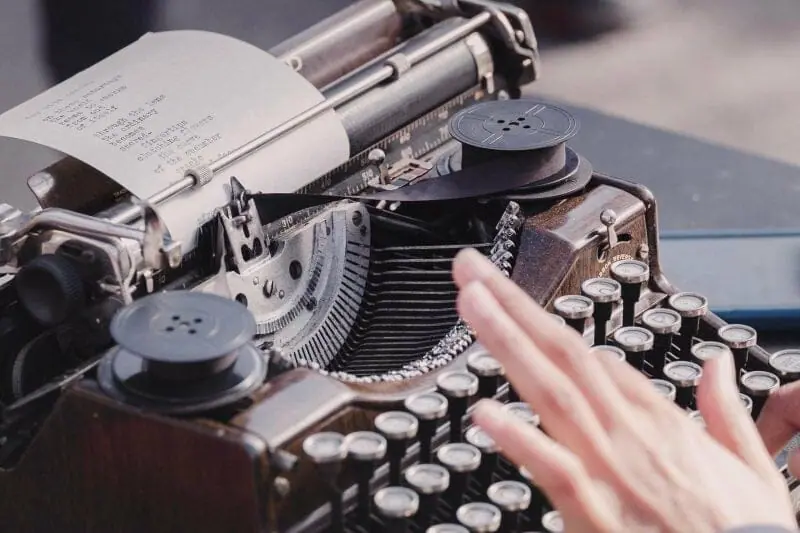A solid rhyme scheme is a surefire way to catch a listener’s ear.
Audiences love it, and rap and hip-hop take it to new heights making great rhymes sound easy.
But sometimes finding the right rhyme can be tricky. Every songwriter knows the familiar feeling of floundering at the end of a line. No decent rhyme in sight and no way out!
Today you’ll learn how to get the most out of one of the most powerful parts of songwriting. By the end of this article, you’ll know how to raise the roof on rhyme, big time.
If you’re like most composers and writers, you’re probably producing your own music as well. We put together a brief training that covers a totally new approach to music production. Until now, everyone has been teaching production totally backward. Just click below to watch. Get industry-quality mixes every time (steal this framework)
But if you just want to learn about Rhyme Schemes specifically, keep reading.
What are Rhyme Schemes?

Rhyme is a crucial part of the songwriting process. It helps solidify the structure and rhythm of a song.
Rhyme spotlights important ideas within a lyric and gives an emotional payoff for earlier lines.
Rhyme increases both the memorability and singability of your song.

We even get a dopamine hit when we hear rhymes “click.” Particularly rhymes at the end of a line, also known as end rhymes.
But rhymes don’t just turn up randomly. They arrive in a structured pattern.
This pattern of end rhyme in a song is called a rhyme scheme.
Getting to grips with rhyme schemes will help you avoid rhymes that sound “cheesy” or corny. ” They will help you feel propelled by rhyme rather than choked by it!
How does a rhyme scheme work?

A rhyme scheme is the pattern of end rhymes. We can keep track of a song’s rhyme scheme using letters from the alphabet.
When two lines end with the same sound, they’re given a letter. So the first rhyme in a song would be A, the second is B, and so on through the alphabet. If the word at the end of a line doesn’t rhyme with any other, it’s given an X.
So how do we create patterns with rhyme?
In song, there are two dominant groups of schemes used. Four-line schemes and six-line schemes.
There are exceptions. But a good place to get a handle on this is to start with those most often used.
The Most Popular Four-Line Rhyme Schemes
#1: AABB
An AABB rhyme scheme is made up of four lines. The first two lines are a pair, as are the last two lines.
Each of the pairs has a different rhyme. This type of end rhyme is also referred to as a couplet.
You can see this at work in Simon and Garfunkel’s The Sound of Silence.
Hello darkness, my old friend
I’ve come to talk with you again
Because a vision softly creeping
Left its seeds while I was sleeping
The end rhyme of the first pair, or couplet, is friend with again. That’s our A rhyme.
The second couplet also rhymes. But it uses a different sounding rhyme – creeping with sleeping – and that’s the B rhyme.
This scheme also unites each new idea with a couplet. Once the rhyming couplet finishes, a new couplet (and idea) starts. Have another look:
Idea 1 – the A rhyme
Hello darkness, my old friend
I’ve come to talk with you again
Idea 2 – the B rhyme
Because a vision softly creeping
Left its seeds while I was sleeping
This way of moving your ideas through the song (particularly the verses, IMHO) is called topic movement.
It’s a key reason why rhyme schemes are so well used in song. We hear rather than read the words.
#2: ABAB
This very popular scheme has interlocking rhymes. ABAB is also known as alternate rhyme.
Here is how you can write it:
- Rhyme the first line with the third.
- Rhyme the second line with the fourth, but use a different vowel sound.
A good example is Scarborough Fair. This is a traditional English folk tune made evergreen by Simon and Garfunkel.
Are you going to Scarborough Fair?
Parsley, sage, rosemary, and thyme
Remember me to one who lives there
For once she was a true love of mine
#3: AAAA
This scheme has all the lines ending with the same rhyme. It’s also known as monorhyme.
Using this scheme is harder to keep sounding fresh, but it’s great for creating a buildup.
Here’s Sam Smith’s Latch.
You lift my heart up when the rest of me is down
You, you enchant me even when you’re not around
If there are boundaries, I will try to knock them down
I’m latching on, babe, now I know what I have found
#4: ABBA
This rarer scheme works as a sandwich. It’s called an enclosed or envelope rhyme.
You rhyme the first line with the last one. Then the two lines between them rhyme with each other, but the rhyme sounds different.
Here’s James Taylor’s Sweet Baby James.
There is a young cowboy, he lives on the range
His horse and his cattle are his only companions
He works in the saddle and he sleeps in the canyons
Waiting for summer his pastures to change
#5: AAAB
Everything rhymes except for the very last line in the verse. Often, this last line has a completely different amount of syllables as the three lines before it.
Here’s Coldplay with the verse scheme from Fix You.
When you try your best but you don’t succeed
When you get what you want but not what you need
When you feel so tired but you can’t sleep
Stuck in reverse
When the tears come streaming down your face
‘Cause you lose something you can’t replace
When you love someone but it goes to waste
What could be worse?
The next three schemes (well, four really) have more relative freedom and flexibility. They mix rhyming lines (A) and non-rhyming lines (X).
The first one is the most popular.
#6: XAXA
In XAXA, you have two lines that do not rhyme with others and two that do.
- Make sure that lines 1 and 3 do not rhyme with each other or with any other line
- Line 2 and line 4 do rhyme with each other.
This scheme’s less predictable, because it has two lines that don’t rhyme with anything.
But it allows the potential for a more natural, conversational way of writing. That makes it a real favorite with contemporary songwriters.
Like The Police, with Everything Little Thing She Does Is Magic.
I resolved to call her up
A thousand times a day
Ask her if she’ll marry me
In some old-fashioned way
provider: youtube
url: https://www.youtube.com/watch?v=sxkMFgFjC8E&list=RDsxkMFgFjC8E&start_radio=1&t=3
src in org: https://www.youtube-nocookie.com/embed/sxkMFgFjC8E?start=3&feature=oembed
src in mod: https://www.youtube-nocookie.com/embed/sxkMFgFjC8E?start=3
src gen org: https://www.youtube-nocookie.com/embed/sxkMFgFjC8E
#7: AXAA and AAXA
With both these schemes, you need to rhyme only three out of four lines.
It is another great opportunity to get a little bit more freedom.
You can vary where that unpredictable unrhymed line turns up. Makes it a little edgy.
Here’s Bruno Mars using an AAXA scheme in Grenade.
I would go through all this pain
Take a bullet straight through my brain
Yes, I would die for you, baby
But you won’t do the same
Here’s Joni Mitchell in Both Sides Now, varying it to AAAX to highlight her last line.
Rows and flows of angel’s hair
And ice cream castles in the air
And feathered canyons everywhere
I’ve looked at clouds that way
#8: AXXA
This rhymes the first line with the last one, like in the envelope scheme ABBA. However, it leaves two unrhymed lines in the middle.
It can let you concentrate on what you want to say but still frame it in a lighter rhyme scheme.
So far, we’ve looked at four-line schemes. But another common way to structure rhyme, especially in verses, is the six-line scheme.
Six Line Schemes

There are two six-line schemes that are used over and over again in popular song.
#1: XXAXXA
The section comes in two parts with the only rhymes landing at the end of lines 3 and 6.
Here’s the verse of Jive Talkin’ by the Bee Gees.
Oh, my child
You’ll never know
Just what you mean to me
Oh, my child
You got so much
You’re gonna take away my energy
#2: AABCCB
This section has three different rhymes. Lines 1 and 2 have the same end rhymes, and lines 4 and 5 rhyme together but are different from the first rhyme.
Finally, lines 3 and 6 are the same end rhyme. This scheme is great to use when there’s a lot to say!
Johnny Cash can show you how in A Boy named Sue.
Well my daddy left home when I was three
And he didn’t leave much to Ma and me
Just this old guitar and an empty bottle of booze
Now, I don’t blame him ’cause he run and hid
But the meanest thing that he ever did
Was before he left, he went and named me “Sue“
But perhaps the champion is Leonard Cohen. He allegedly wrote 80 potential verses for Hallelujah using this structure.
Now, I’ve heard there was a secret chord
That David played, and it pleased the Lord
But you don’t really care for music, doya?
It goes like this, the fourth, the fifth
The minor fall, the major lift
The baffled king composing hallelujah
But don’t stop there. Other variations and examples of six-line schemes include:
#3: AAABBB
Here’s Ed Sheeran at work using it to pile on the pressure in the A-Team verse.
White lips, pale face
Breathing in snowflakes
Burnt lungs, sour taste
Lights gone, day’s end
Struggling to pay rent
Long nights, strange men
#4: XAAXBB
John Mayer tweaks that tension with a subtler mood-appropriate variation in Why Georgia.
I am driving up 85
In the kind of morning that lasts all afternoon
Stuck inside the gloom
Four more exits to my apartment
But I am tempted to keep the car in drive
And leave it all behind
#5: AABAAB
Meanwhile, Shawn Colvin uses this tighter structure to lead us directly to the major change agent, “fire,” in her chorus of Sunny Came Home.
She says days go by
I don’t know why
I’m walking on a wire
I close my eyes
and fly out of my mind
Into the fire
#6: AAAAAA
And to finish, Lizzo provides a monster six-line monorhyme variation. Here’s her chorus of Jerome.
Jerome, Jerome
Take your ass home
And come back when you’re grown
Jerome, Jerome
Go on, take your ass home
Where the peaches have thorns
NEWSFLASH! Rhyme Scheme Defeats Songwriters Block!
What’s exciting about checking out examples of rhyme schemes is that you don’t have to stick with the same old rhyme rut. You have a heap of different options available to you.
Please note these are only SOME of the rhyme schemes you can use.
The sheer variety means you don’t ever have to feel frustrated or blocked. No more scrabbling around trying to rhyme for rhyme’s sake again!
You can just switch schemes, take the pressure off, and get your flow back.
Your ever-loving audience doesn’t want to hear the clunketty-clunk of forced rhymes. We want to delight in your effortless prowess, nevertheless, no stress!
BONUS TIPS
Tip #1 – Don’t memorize all of the schemes, but search out what’s happening in your own songs and what happens in songs you like. They’ll soon become part of your songwriting vocabulary.
Tip #2 – Rhyme schemes are also about structuring your ideas. Align them with your musical phrases.
They construct a kind of internal song grammar, what Professor Andrea Stolpe refers to as “the architectural plans of the lyric.”
Tip #3 – Rhyme schemes are useful to crank up contrast between the sections within your song.
It’s perfectly normal to use a six-line scheme in a verse. Then a four-line scheme in a chorus, and a different four-line scheme in the bridge.
Tip #4 – Life isn’t always even-numbered, either.
Extend (particularly at the end of a section) or add a line to make a five-line or seven-line section. This unbalance creates a great source of tension you can release in the chorus.
George Harrison uses this technique in his five-line AXABB verse of Something In the Way She Moves. It really highlighted the X unrhymed line.
Something in the way she moves
Attracts me like no other lover
Something in the way she woos me
I don’t want to leave her now
You know I believe in how
Tip #5 – You can also work with different schemes between your songs to develop the breadth of your repertoire.
It’s similar to working with a new chord progression. Changing up your rhyme scheme can really refresh your material.
Tip #6 -You can mix and match different schemes within your song sections to build longer verses.
Here’s the second verse from Eminem’s Lose Yourself doing just that. A heady mix of AABB, CDCD, and XAXA rhyme schemes. Enjoy!
The souls escaping, through this hole that is gaping
This world is mine for the taking
Make me king, as we move toward a new world order
A normal life is borin’, but super stardom’s close to postmortem
It only grows harder, only grows hotter
He blows us all over, these hoes is all on him
Coast to coast shows, he’s known as the globetrotter
Lonely roads, God only knows, he’s grown farther from home
He’s no father, he goes home and barely knows his own daughter
But hold your nose ’cause here goes the cold water
His hoes don’t want him no mo’, he’s cold product
They moved on to the next schmo who flows, he nose dove and sold nada
So the soap opera is told and unfolds, I suppose it’s old partna
but the beat goes on, Da da dumb da dumb da da
Conclusion: Rhyme Schemes
The main thing to think about is that there is a whole raft of options to structure your rhymes so they work for you. Rather than feeling forced into using words in ways that sound, well, naff.
There are loads of songs that deliberately don’t use end rhymes in certain places, and they sound great.
You can shuffle schemes between verses and choruses. Try out schemes you’ve never used before in your latest song.
So if you find yourself struggling, flick over some of the choices available. It could release you from the bind of rhyme to come up with your best lines each and every time.
If you want to dig deeper into music production and learn what it actually takes to make mixes that sound pro… And you’re an intermediate or advanced producer… Be sure to check out the free masterclass: Enjoy!Next Steps















